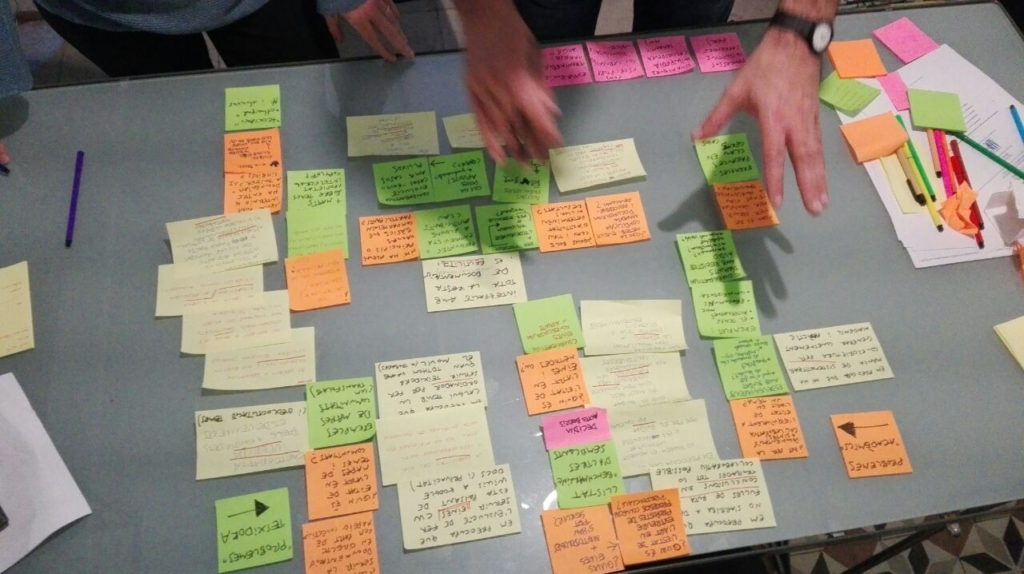This January I just started the fieldwork for my PhD project, which in this case means (apart from some interviews and analysis of materials) to combine the role of co-creation facilitator with direct observation, and other ways of gathering relevant data about the adoption of co-design and agile for collaborative research.
For this, the calendar of several research processes are just starting and the people behind them coordinating with me in order to have specific sessions for the collaborative definitions of what to develop as collaborative enquiry and how. This coincides, in all cases, with a previous agreement that based on some design thinking techniques I will lead the initial co-definition of issues, questions and methods (following principles of collective visualization, iterative discussions and prioritisations, among other techniques) for trying to find consensus about a clear collaborative research plan in different contexts. The second part of what I’m interested to test and observe (that is, the adoption of agile management for the development of the research itself), is still not happening but is also part of the agenda after those collaboratively designed plans are validated, and participants starting to work on them regularly.
The cases, which are all potentially embedded case studies of different sizes, types and goals, represent in my opinion a good palette of current collaborative practices related to research. I’m trying to approach them with a lot of respect and transparency about my own goals as researcher, as well as glad to have full confidence in my work from the people and organisations responsible for them. However, there are preconditions in order to include them as proper cases for the data gathering process I’m just starting: there has to be at least one researcher involved (from a research institution) and also intentions to produce some type of academic output (apart from other important ones, like some type of social impact or practical solution to a given issue or concern).
This is the current overview of the three initial cases, and how I just started to work with other people in making possible this research “co-creation” approach:
Case #1: Action research project and paper about Teixidora as a digital tool and strategy for mapping socio-technical issues, communities and events in Barcelona. After Teixidora’s first year of intense activity, in this case the goal is to co-write a paper for an academic journal about this initiative, a collaborative mashup of an etherpad and Semantic wiki for taking collaborative notes “live”, during events related to technology and society at the local level. The team behind the project collaborates with my research group, and four of us in total are starting to visualize what the core structure of the paper could be, after an initial session identifying challenges, questions and available data (and clustering them on a holistic map of issues). Apart from the paper, the other goal in parallel is to identify the most pressing needs and features to develop for the project at the technical level. For this case I have opted for a very simple and basic approach when it comes to materials and interaction: postits of different colours and sizes, and basic indications about how to use them, trying to benefit from such small scale collaboration and proximity feedback.

Case #2: STEM4Youth project and citizen science experiments, co-developed with three Secondary Schools in the area of Barcelona. For this European project I have the opportunity to collaborate with the OpenSystems Barcelona team from University of Barcelona, leaded by Josep Perelló who is a reference in citizen science and multidisciplinary approaches to research. The challenge of this scale of facilitation for me is that there’s three different groups of students from three different Secondary schools collaborating in the process. With Josep’s team and other collaborators, last week we started to bring co-design for citizen science in very short sessions (around 90 minutes each) for different groups. One of the things that I like and find encouraging in this context is that the current “alpha” version of the toolkit is going to be tested and “put to a limit”, somehow, by large groups of teenagers, who usually represent in my opinion the best way of trying out complex things (or in better words, to make them less complicated and more accessible if you want them to work).

Case #3: On Friday afternoon I had a third initial session with a different group and type of issues, again with a facilitation and but in this case with an interesting combination of diverse participants compared to the previous two cases: one lead researcher, a research assistant, one service designer and three members of Coopdevs, a non-profit organisation of open source developers trying to advance in the definition of their project, a platform coop for local consumer groups of agroecological food. So again from the perspective of action research, and like in the first case trying to map issues and concerns by very basic means (postits, markers, an empty surface for clustering topics according to simple “rules”) the session goal in this occasion was to find a balance between the researcher’s interest in how consumer groups are adopting digital tools, and what type of software and organisation should be developed in order to make an impact and be economically sustainable at the same time, behind a concept we coined as “sustainable activism”.

During the following weeks the co-design sessions about citizen science are going to intensify, while the other two cases run at smaller scales and now is time to start to process the initial research designs produced. In parallel, I’m starting to interview other researchers who are involved in collaborative projects (in some cases trying to apply co-design or agile in their work) and latter on I have more interviews planned with designers and practitioners of agile.